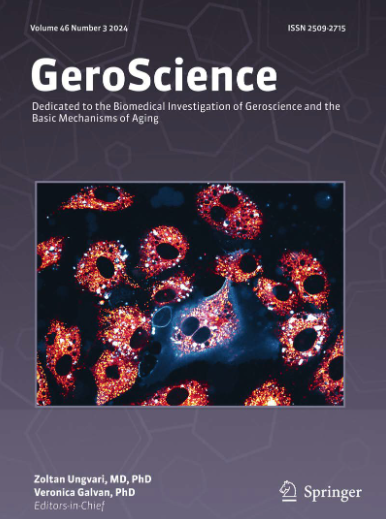衰老抑制p53亚型Δ133p53α:增强癌症免疫治疗和探索衰老相关疾病的新治疗方法。
IF 5.4
2区 医学
Q1 GERIATRICS & GERONTOLOGY
引用次数: 0
摘要
Δ133p53α是肿瘤抑制蛋白p53的天然异构体。Δ133p53α作为全长p53蛋白(通常称为p53)的生理显性阴性抑制剂。Δ133p53α优先抑制p53介导的细胞衰老,而不抑制甚至可能促进p53介导的DNA修复。由于这种保持基因组稳定性的选择性抑制活性,Δ133p53α代表了一个有希望的目标,可以加强与正常细胞衰老增加相关的疾病的预防和治疗。这些疾病包括阿尔茨海默氏症和其他神经退行性疾病,如哈钦森-吉尔福德早衰综合征(HGPS)和特发性肺纤维化(IPF)等早衰性疾病。目前的基于细胞的治疗受到细胞衰老增加的限制,也可能受益于Δ133p53α-mediated的改善。作为Δ133p53α在改善治疗性细胞中的初步应用,我们在此引入Δ133p53α-armored嵌合抗原受体(CAR)-T细胞。基于我们之前和正在进行的使用各种类型的体外衰老人类细胞的研究,我们还讨论了进一步探索Δ133p53α治疗潜力的重要性,特别是关注HGPS和IPF。小鼠模型的发展促进了Δ133p53α治疗效果的体内评估,可能导致未来的临床应用。本文章由计算机程序翻译,如有差异,请以英文原文为准。
The senescence-inhibitory p53 isoform Δ133p53α: enhancing cancer immunotherapy and exploring novel therapeutic approaches for senescence-associated diseases.
Δ133p53α is a naturally occurring isoform of the tumor suppressor protein p53. Δ133p53α functions as a physiological dominant-negative inhibitor of the full-length p53 protein (commonly referred to as p53). Δ133p53α preferentially inhibits p53-mediated cellular senescence, while it does not inhibit, or may even promote, p53-mediated DNA repair. Owing to this selective inhibitory activity that preserves genome stability, Δ133p53α represents a promising target for enhancement in the prevention and treatment of diseases associated with increased senescence of normal cells. These diseases include Alzheimer's and other neurodegenerative diseases, premature aging diseases such as Hutchinson-Gilford progeria syndrome (HGPS), and idiopathic pulmonary fibrosis (IPF). Current cell-based therapies, which are limited by increased cellular senescence, may also benefit from Δ133p53α-mediated improvements. As an initial application of Δ133p53α in improving therapeutic cells, we here introduce Δ133p53α-armored chimeric antigen receptor (CAR)-T cells. Based on our previous and ongoing studies using various types of senescent human cells in vitro, we also discuss the importance of further exploring the therapeutic potentials of Δ133p53α, with particular focus on HGPS and IPF. The development of mouse models facilitates in vivo evaluation of the therapeutic effects of Δ133p53α, potentially leading to future clinical applications.
求助全文
通过发布文献求助,成功后即可免费获取论文全文。
去求助
来源期刊

GeroScience
Medicine-Complementary and Alternative Medicine
CiteScore
10.50
自引率
5.40%
发文量
182
期刊介绍:
GeroScience is a bi-monthly, international, peer-reviewed journal that publishes articles related to research in the biology of aging and research on biomedical applications that impact aging. The scope of articles to be considered include evolutionary biology, biophysics, genetics, genomics, proteomics, molecular biology, cell biology, biochemistry, endocrinology, immunology, physiology, pharmacology, neuroscience, and psychology.
 求助内容:
求助内容: 应助结果提醒方式:
应助结果提醒方式:


